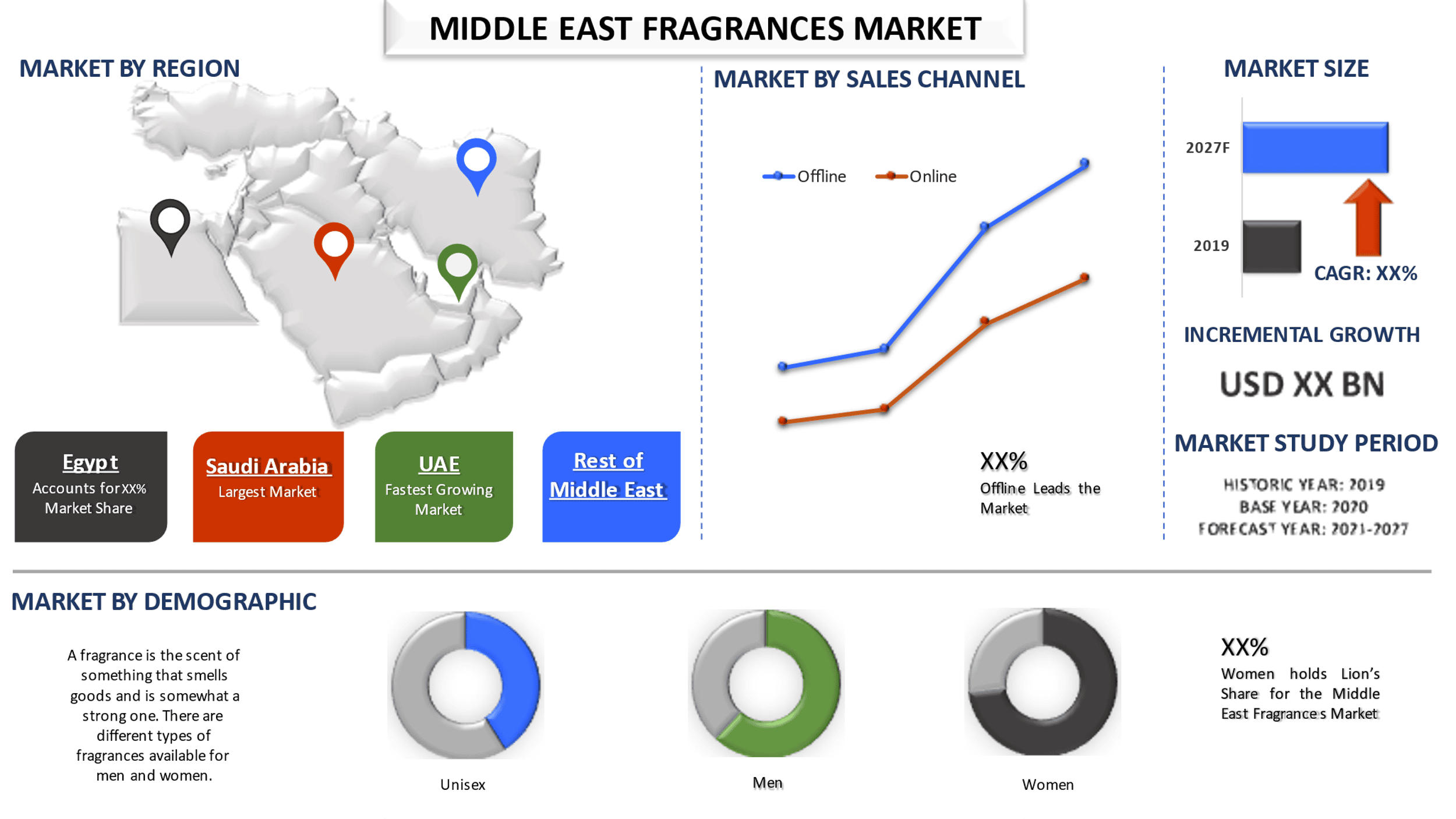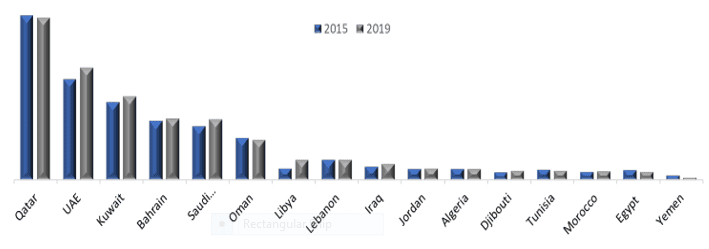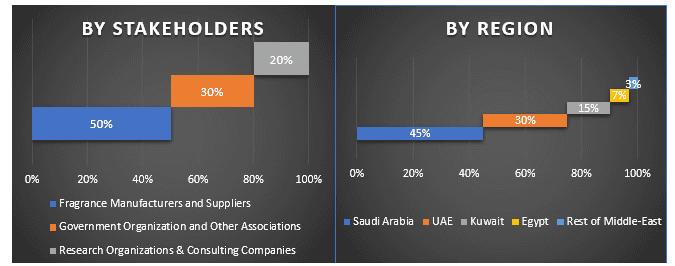- Home
- About Us
- Industry
- Services
- Reading
- Contact Us
Middle East Fragrances Market: Current Analysis and Forecast (2021-2027)
Emphasis on Demographics (Men, Women, Unisex); Sales Channel (Offline, Online); Region/Country

Middle East Fragrances Market was valued at US$ 3 billion in 2020 and is expected to grow at a CAGR of 7.5% over the forecast period (2021-2027). A fragrance is the scent of something that smells goods and is somewhat a strong one. It is especially associated with flowers and is used to describe things that have a pleasant and strong scent. The cosmetic fragrances are applied to the body of a person to emit a pleasant smell and include perfume, cologne, and aftershave.
Middle East countries are known for its thriving fragrances and perfume industry as fragrances are an integral part of their culture and tradition due to which consumers in this region tends to buy scent in bulk. For example, one of the traditions that have been passed down through generations in the region is using the smoke of oud sticks by women to permeate their hair. Owing to the growing integration of scents in tradition and the emergence of aromachology the sales of fragrances is huge in the region. For instance, in the Middle East, 3 bottles of perfumes are sold every second and fragrances make up almost 70% of the prestige beauty category.
Furthermore, the growth of the market is attributed to the surge in disposable incomes which is leading to the rise in consumer spending on luxury products including perfumes and fragrances. For instance, nearly, 60% of the region’s population are millennials with independent spending power & has a willingness to try new products from niche brands in the Middle East. In addition to this, the growing tourism, presence of well-established industry players, and penetration of social media marketing in the region are also driving the fragrance market. However, the availability of counterfeit products and the use of chemical ingredients with probable side effects are impeding market growth.
GDP per capita, Current USD in MENA, 2015 & 2019

Gucci, LMVH, Rasasi, Yas Perfumes, Calvin Klein, The Fragrance Kitchen, Ajmal, Arabian Oud, Abdul Samad Al-Qurashi, Al-haramain are some of the prominent players operating in the Middle East fragrances market. Several M&As along with partnerships have been undertaken by these players to facilitate customers with innovative products.
Insights Presented in the Report
“Amongst Demographics, women segment holds the major share”
Based on demographics, the Middle East Fragrances market is segmented into men, women, and unisex. The women segment accounted for a market valuation of US$ XX billion in 2020 and is expected to reach US$ XX billion by the year 2027 growing with a CAGR of XX% over the projected timeframe. The growth of this segment is attributed to the increase in working women coupled with the need to maintain their strong identity leading to the growing expenditure on cosmetics and scents. However, the male segment is also expected to grow at a significant CAGR of XX% owing to the growing awareness to maintain their well-being among men in the region.
“Amongst Sales Channel, offline segment holds the major share”
Based on sales channels, the Middle East fragrances market is bifurcated into offline and online. The offline segment accounted for a market valuation of US$ XX billion in 2020 and is expected to reach US$ XX billion by the year 2027 growing with a CAGR of XX% over the projected timeframe as e-commerce makes only around 3% of retail sales in the region. However, the online segment is anticipated to grow at a considerable CAGR in the upcoming years owing to the growing penetration of e-commerce and rapid growth in mobile and internet users in the region. For instance, as of April 2019, the internet penetration rate in the Middle East was 67.2% among the local population while the internet penetration rate for the rest of the world was around 56.8%.
“Saudi Arabia represents one of the largest markets of fragrances market”
For a better understanding of the market dynamics of the fragrances market, a detailed analysis was conducted for different regions across the Middle East countries including Saudi Arabia, UAE, Kuwait, Egypt, and the Rest of the Middle East. Saudi Arabia dominated the market and grabbed around XX% market share owing to growth in the young population and an increase in the consumer expenditure capacity in the country.
Reasons to buy this report:
- The study includes market sizing and forecasting analysis validated by authenticated key industry experts
- The report presents a quick review of overall industry performance at one glance
- The report covers an in-depth analysis of prominent industry peers with a primary focus on key business financials, product portfolio, expansion strategies, and recent developments
- Detailed examination of drivers, restraints, key trends, and opportunities prevailing in the industry
- The study comprehensively covers the market across different segments
- Deep dive regional level analysis of the industry
Customization Options:
Middle East fragrances market can further be customized as per the requirement or any other market segment. Besides this, UMI understands that you may have your own business needs, hence feel free to connect with us to get a report that completely suits your requirements.
Table of Content
Analyzing the historical market, estimation of the current market, and forecasting the future market of the Middle East fragrances market were the three major steps undertaken to create and analyze the adoption of fragrances in major countries of the Middle East. Exhaustive secondary research was conducted to collect the historical market numbers and estimate the current market size. Secondly, to validate these insights, numerous findings and assumptions were taken into consideration. Moreover, exhaustive primary interviews were also conducted, with industry experts across the value chain of the Middle East fragrances market. Post assumption and validation of market numbers through primary interviews, we employed a top-down/bottom-up approach to forecasting the complete market size. Thereafter, market breakdown and data triangulation methods were adopted to estimate and analyze the market size of segments and sub-segments the industry pertains to. Detailed methodology is explained below:
Analysis of Historical Market Size
Step 1: In-Depth Study of Secondary Sources:
Detail secondary study was conducted to obtain the historical market size of the fragrances market through company internal sources such as annual report & financial statements, performance presentations, press releases, etc., and external sources including journals, news & articles, government publications, competitor publications, sector reports, third-party database, and other credible publications.
Step 2: Market Segmentation:
After obtaining the historical market size of the fragrances market, we conducted a detailed secondary analysis to gather historical market insights and share for different segments & sub-segments for major regions. Major segments are included in the report as demographic and sales channels. Further country-level analyses were conducted to evaluate the overall adoption of fragrances in that region.
Step 3: Factor Analysis:
After acquiring the historical market size of different segments and sub-segments, we conducted a detailed factor analysis to estimate the current market size of fragrances. Further, we conducted factor analysis using dependent and independent variables such as an upsurge in disposable income and improvement in living standards. A thorough analysis was conducted for demand and supply-side scenarios considering top partnerships, merger and acquisition, business expansion, and product launches in the fragrances sector across the region.
Current Market Size Estimate & Forecast
Current Market Sizing: Based on actionable insights from the above 3 steps, we arrived at the current market size, key players in the fragrances market, and market shares of the segments. All the required percentage shares split, and market breakdowns were determined using the above-mentioned secondary approach and were verified through primary interviews.
Estimation & Forecasting: For market estimation and forecast, weights were assigned to different factors including drivers & trends, restraints, and opportunities available for the stakeholders. After analyzing these factors, relevant forecasting techniques i.e., top-down/bottom-up approach was applied to arrive at the market forecast about 2027 for different segments and subsegments across the major markets globally. The research methodology adopted to estimate the market size encompasses:
- The industry’s market size, in terms of value (US$) and the adoption rate of fragrances across the major markets domestically
- All percentage shares, splits, and breakdowns of market segments and sub-segments
- Key players in the fragrances market in terms of products offered. Also, the growth strategies adopted by these players to compete in the fast-growing market
Market Size and Share Validation
Primary Research: In-depth interviews were conducted with the Key Opinion Leaders (KOLs) including Top Level Executives (CXO/VPs, Sales Head, Marketing Head, Operational Head, and Regional Head, Country Head, etc.) across major regions. Primary research findings were then summarized, and statistical analysis was performed to prove the stated hypothesis. Inputs from primary research were consolidated with secondary findings, hence turning information into actionable insights.
Split of Primary Participants in Different Regions
Market Engineering
Data triangulation technique was employed to complete the overall market estimation and to arrive at precise statistical numbers of each segment and sub-segment of the fragrances market. Data was split into several segments & sub-segments post studying various parameters and trends in the areas of demographics and sales channels of the fragrances market.
The main objective of the Middle East Fragrances Market Study
The current & future market trends of fragrances were pinpointed in the study. Investors can gain strategic insights to base their discretion for investments from the qualitative and quantitative analysis performed in the study. Current and future market trends were determined the overall attractiveness of the market at a regional level, providing a platform for the industrial participant to exploit the untapped market to benefit as a first-mover advantage. Other quantitative goals of the studies include:
- Analyze the current and forecast market size of fragrances in terms of value (US$). Also, analyze the current and forecast market size of different segments and sub-segments
- Segments in the study include areas of demographic and sales channels
- Define and analysis of the regulatory framework for the fragrances industry
- Analyze the value chain involved with the presence of various intermediaries, along with analyzing customer and competitor behaviors of the industry
- Analyze the current and forecast market size of the fragrances market for the major countries
- Major countries studied in the report include Saudi Arabia, UAE, Kuwait, Egypt, and Rest of Middle East.
- Company profiles of the fragrances market and the growth strategies adopted by the market players to sustain in the fast-growing market
Deep dive regional level analysis of the industry
Related Reports
Customers who bought this item also bought










